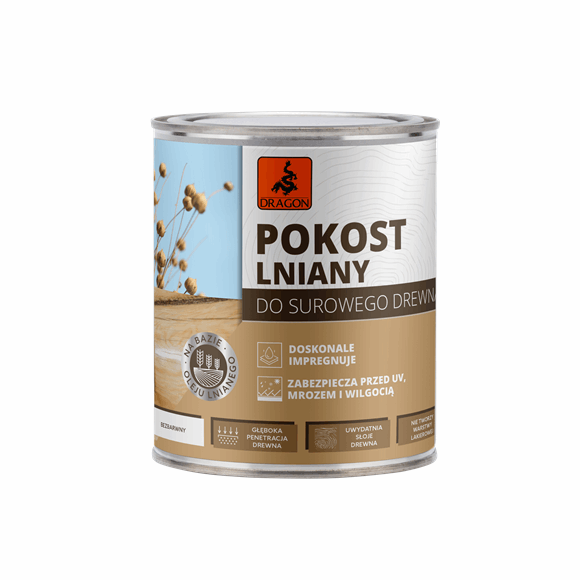Dostawa od 10,99 zł
Zamów w przeciągu 02:21:32 a wysyłkę otrzymasz jutroLinseed varnish for wood

Linseed varnish for wood
A natural product based on concentrated linseed oil with additives to accelerate drying, intended for wood impregnation.
Protects the wood against water and adverse weather conditions (temperature, UV radiation).
Protects the wood against cracking and drying out.
A single use protects the wood for many years without additional seasonal application.

Linseed varnish for wood
A natural product based on concentrated linseed oil with additives to accelerate drying, intended for wood impregnation.
Protects the wood against water and adverse weather conditions (temperature, UV radiation).
Protects the wood against cracking and drying out.
A single use protects the wood for many years without additional seasonal application.
APPLICATION:
Linseed varnish is intended for the impregnation of raw wood and wood-based materials used indoors and outdoors (doors, windows, furniture, fences, gazebos, pergolas, greenhouses, summer houses, gates, balustrades, garden furniture, panelling, etc.).
The varnish can also be used for the maintenance of dog kennels, cages, feeders and aviaries, i.e. where animals come into direct contact with wood.
Sample application sites:
Dostępne kolory
Find out how to take advantage


- 1 Mix thoroughly before use.
- 1 Apply the varnish evenly with a brush, roller or cloth.
- 2 Leave for about 30 minutes (at 20°C) until it penetrates into the wood.
- 3 Polish the surface with a dry cloth.
- 4 When rubbing and polishing, be careful to remove any excess agent.
- 5 The excess will not dry and will remain sticky, leaving a visible difference in gloss.
- 6 The varnish must penetrate the wood completely without creating a visible surface on the wood.
- 1 Mix thoroughly before use.
- 1 Apply the varnish evenly with a brush, roller or cloth.
- 2 Leave for about 30 minutes (at 20°C) until it penetrates into the wood.
- 3 Polish the surface with a dry cloth.
- 4 When rubbing and polishing, be careful to remove any excess agent.
- 5 The excess will not dry and will remain sticky, leaving a visible difference in gloss.
- 6 The varnish must penetrate the wood completely without creating a visible surface on the wood.
In the case of very absorbent wood, the varnish can be diluted 1: 1 with, for example, DRAGON Oil-phthalate thinner or DRAGON Balsamic turpentine.
In the case of very absorbent wood, the varnish can be diluted 1: 1 with, for example, DRAGON Oil-phthalate thinner or DRAGON Balsamic turpentine.
No usage data available for this product.
- Wooden elements to be impregnated must be raw wood, clean, dry, degreased, smoothly sanded, in good condition and absorbent.
- Before painting, perform a test in an inconspicuous place in order to assess possible differences in the colour of the wood and to exclude potential interactions with substances in the substrate.
- Carry out work at temperature (10÷30)°C.
- High air humidity, low temperature, large quantities of varnish or a high tannin content in the wood can extend the varnish’s drying time.
- After the varnish has dried, the substrate should not be painted with water-based, epoxy or polyurethane paints.
- After 24 hours drying (at 20ºC), the substrate can be painted with oil or phthalic topcoats.
- Full surface hardness is obtained after approximately 4 tygodniach.
- Treat with care until that time.
- After finishing the task, wash the tool immediately with balsamic turpentine or oil-phthalic thinner.
- Wooden elements to be impregnated must be raw wood, clean, dry, degreased, smoothly sanded, in good condition and absorbent.
- Before painting, perform a test in an inconspicuous place in order to assess possible differences in the colour of the wood and to exclude potential interactions with substances in the substrate.
- Carry out work at temperature (10÷30)°C.
- High air humidity, low temperature, large quantities of varnish or a high tannin content in the wood can extend the varnish’s drying time.
- After the varnish has dried, the substrate should not be painted with water-based, epoxy or polyurethane paints.
- After 24 hours drying (at 20ºC), the substrate can be painted with oil or phthalic topcoats.
- Full surface hardness is obtained after approximately 4 tygodniach.
- Treat with care until that time.
- After finishing the task, wash the tool immediately with balsamic turpentine or oil-phthalic thinner.
No read before use data available for this product.
Technical data
| SKU | |
|---|---|
| Ean | |
| Grammage | |
| Applicability | interior or exterior |
| Efficiency | ~10m²/L |
| Coating total drying time | 24h |
| Initial hardening/drying time of the joint/coating | 30min |
| Joint/coating color after drying | Transparent |
| Typ produktu | based on thickened linseed oil |
Security
- Cleaning cloths soaked in varnish can cause spontaneous combustion.
- Never leave rolled up or bundled with cotton, or with oil-soaked cloths!
- Under such conditions the oil oxidises, generating heat, and the fabric may ignite!
- Before discarding, spread the material out to expose it to the air and dry it well.
- Dispose of contaminated, dried cloths.
- During and after the works, the room must be intensively ventilated until the characteristic odor disappears.
- If the instructions on the packaging are not followed, the manufacturer is not responsible for the impregnation effect.
- Keep out of reach of children.
Storage and transport
- Transport and store upright in a tightly closed, original packaging at temp. (0÷30) °C.

Lets take care of the environment
VOC:
Category A, subcategory g: Primers with binding properties, type FR; the maximum permissible VOC content is 350 g/L, the maximum VOC content in the product is <30 g/L.



